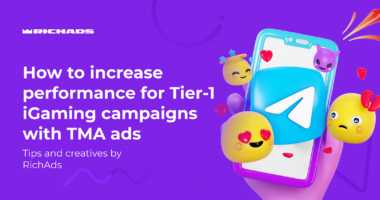Mobile is everywhere – but what does this mean for the affiliate marketing world & your advertising?
There are 6.9 billion mobile users in the world, and this number is only increasing. The mobile world is the dominant realm for all of the digital world.
Within the past five years, time spent on mobile internet has eclipsed time spent on desktop internet. People spend more than 4 times as much time on mobile than on desktop. I remember the days of sharing the family computer and sitting around it with my friends watching YouTube videos.
Now we just make a quick group chat, send whatever we want by some social media channel, and hope our friend checks out that article/meme/video you’ve now sent for the fourth time. But that’s beside the point.
With so much mobile traffic, this is giving way to an extremely effective and innovative style of performance-based marketing: mobile affiliate advertising.
Mobile vs Desktop use in 2024
According to stats, mobile outgrows desktop traffic and continues to rise all over the world. Mobile traffic constitutes a whooping 55% of total Internet traffic in 2024, with Africa leading the way in mobile Internet usage. Most newly connected people use smartphones to access the global network. The ‘mobile-first’ approach to design and marketing is not a trend but a necessity.
What is Mobile Affiliate Marketing & why is it worth it?
Mobile affiliate marketing is essentially affiliate marketing, but for mobile phones, and on mobile internet. This specialized form of performance marketing developed in response to the ever-growing number of mobile users on apps, responsive websites, and mobile internet overall.
In the early days of affiliate marketing, advertisers in the affiliate industry focused heavily on desktop – that’s what most people had, and mobile internet was neither affordable nor convenient. As affiliate marketing grew throughout the 2000s, so did another digital trend: smart phones.
Internet traffic is increasingly mobile. I’m not saying desktops are irrelevant or that nobody owns a laptop anymore – but, people are spending more and more time scrolling on their phones.
What started as a clunky experience (think clicking the cancel button forty times when you accidentally opened the internet on your flip phone and didn’t want to charge your parents plan) has become a smartphone in almost everyone’s pocket, forever connected to the internet.
The mobile market is booming and mobile affiliate marketing is blooming alongside it – it’s becoming the most important money maker for affiliate marketers.
For now, all you need to keep in mind that regular affiliate marketing and mobile affiliate marketing are indeed different. We’ll get to the details soon enough.
However, the basics of the affiliate-publisher-offer owner structure remain the same.

Mobile Offers types
Mobile offers usually stick to a few core models. You probably won’t be making big purchases on mobile or ones that take a lot of time.
The offers popular for mobile affiliate marketing are usually brief, free, low-cost or subscription based.
- Subscription: signing up to a subscription service such as a monthly wine club delivery, some kind of media service like Netflix, or a SaaS like our tracker
This could include users providing their card information.
- App installs: downloading an app – typically free but sometimes paid.
- Product purchase: though this may not be the main type of offer in the mobile affiliate marketing world, there still are plenty of affiliate link-product purchase type offers. Just because you may not be buying big purchases on your phone doesn’t mean you aren’t buying anything. This can sometimes include a special discount or promo code.
- Calls: incentivizing internet users to call up a certain service or business. This is not necessarily always a call per say, but can take the form of a lead, the next model offer…
- Lead-based: Rather than getting a call, a business may want users to fill out a form, provide an email address, or some other kind of information – and it’s the affiliate’s job to get people to provide this.
Payout Models
Due to the nature of mobile affiliate marketing offers, the payout methods for affiliates follow a certain format as well.
- CPA (Cost per Action)
- CPL (Cost per Lead)
- CPI (Cost per Install)
These correspond to the aforementioned types of offer models – of course there may be some overlap in whether a call counts as a lead or action, but generally, these are the most popular ways for affiliates to get paid.
Mobile Marketing Publishers
Publishers provide the “supply” or, in other words, the traffic for mobile adverts. And in turn, the conversions & commissions for mobile affiliate marketers. There are three main categories of publishers. Sometimes affiliates interact directly with them to secure traffic, but much more often, you will get that traffic faster and easier through an ad network.
The three main kinds of publishers:
- Website owners: otherwise known as webmasters, these are the people behind websites with, ideally, large amounts of traffic, visitors who will click on the ads displayed on a mobile version of that website
- App owners: apps have tons of prequalified visits every day. The owners of these typically “freemium” apps make their money by displaying adverts. Usually, you can pay to have an ad-free experience.
- Social media (and influencers): people pay big money for influencers to display their product or brand, or even become the face of their brand. This isn’t necessarily limited to mobile. But, given the fact that the majority of all social media channels are mobile-centered, it’s pretty evident what style of ad should be designed.
Mobile Ad Channels
Where can mobile ads appear? On what channels? Overall, there are two main platforms for mobile advertising: in-app and mobile web.
These are also the two main sources of traffic that ad networks will deliver your mobile view, clicks and conversions from.
In-app adverts are just as the same suggests – inside of apps. This encompasses a wide range of ad types in a variety of app types. Lots of “a”s. To provide concretes here are some examples below that I compiled with some extensive research (opening almost any app on my phone and taking a screenshot 

First, we have an ad in a mobile game which is probably pretty accurate in describing my mental age. Sure, 92, why not.
Then we have a nice, aesthetically-pleasing fitness video ad in my Instagram feed. Both appear in the apps I use.
And our other main channel is the mobile web. This refers to when you use the internet on your phone (using Google Chrome, Safari, Firefox, etc.) and you land on websites that are optimized for mobile. Here you may (and most likely will) run into ads that are run online but for mobile channels.
Here’s a banner ad for Nissan at the bottom of this CBS news article. Was I watching a New York gangster documentary the night before and looking up everyone mentioned? Yes. But that’s besides the point.
Types of Mobile Ads
Some types of mobile ads are essentially normal ads formatted and designed for mobile. However, other types are exclusively designed for smartphones – especially for in-app traffic.
Banner
The classic, attention-grabbing banner ad with some engaging graphics or text, always with a call to action.
Fullscreen / Interstitial
The ads that cover your entire screen (demanding all of your attention – and sometimes annoyance) that typically pop up during a transition phase in an app.
Video
As video content becomes increasingly prevalent and powerful (think of platforms like TikTok) so do video ads. Always remember to include a CTA.
Native
This refers to native ads that are designed for responsive websites or for specific apps. Including social media apps. These ads try to blend in as much as possible with their surroundings, while also catching the eye of users.
Gamified mobile ads
We all have that addicting game or two on our phone, no? Gamified ads in mobile apps are usually quite a challenge for affiliates in terms of design and development, but they are extremely effective and engaging for users playing games on their mobile devices. As it becomes more commonplace, advertising this way will probably become easier.

While some of these are perfect for mobile affiliate marketing, others require a bit more industry and technical knowledge to advertise your affiliate offers.
How to make money with Mobile Affiliate Marketing
Though the basic elements of mobile affiliate marketing look the same as regular affiliate marketing, mobile advertising in itself has a trove of its own advantages and aspects to consider.
Don’t try to use the same exact models for mobile advertising as you do for desktop audiences – it won’t work as well. Make sure your affiliate ads for smartphone users are properly adjusted for their smaller screens.
As long as you adjust your approach, making money online with the mobile marketing boom is a surefire affiliate marketing strategy.
Desktop vs Mobile Users
What’s key to keep in mind about cellphone users as opposed to desktop users is their mindset.
A mobile user, like I mentioned above, is probably not going to make a big, important purchase on their cell phone. If a purchase or product requires in-depth research or detailed examination, again, users will most likely do this on a desktop computer.
Another aspect is accounting for the on-the-go nature of mobile. Though I’m fairly certain we all spend a couple hours laying on the couch or in bed scrolling aimlessly (especially these days), mobile users are usually just that – mobile.
Purchase or action flows should be short, sweet and designed for the mobile experience. People are usually jumping between apps on their mobile devices anyways. So, if something is going to take too long, they will probably just hit the home button and move on to the next thing in the same instant.
Mobile Apps
If you’ve read attentively (to previous sections 
As long as you consider the demographic of the app’s users and the target audience of your advertisement, in-app traffic provides you tons of pre-qualified leads as they have already affirmed their interest or commitment by downloading the given app before.
Another option is to make your own app. Just as you might make your own website, social media channel or video platform to garner traffic, you can make an app. However, this is a lot trickier.
Though this quality traffic for app owners is quite valuable, the work that goes into developing an app requires enough coding and design knowledge. Or you can hire someone to do it for you at a price.
Targeting Options
One huge advantage of mobile advertising is the load of targeting options available to you. There can be more targeting factors for smartphone users as opposed to desktop audiences and, typically, they are more precise.
But targeting isn’t just a benefit – it’s a necessity. Users absolutely do not want to see content that is irrelevant to them. So make sure you’re showing valuable content that’s tailored to the right users.
In terms of people’s mobile devices, you have a number of targeting options: carrier, internet connection, type of device, OS.
In terms of user demographics, account for: gender, language, favorite mobile websites, shopping habits, age, location.
On-the-go traffic
One of the greatest benefits of mobile advertising: your traffic is literally on the move.
Of course, you can identify the general area of a mobile device, but you can also take advantage of its changing, precise location with mobile users.
If app users opt in for location services, they can receive geotargeted ads. Geotargeting used to just be about targeting users based on their location be it country, region, city or street. But now, mobile advertisers can deliver tailored content depending on what metro stop they’re currently standing at.
Geofencing is the practice of delivering an ad to a mobile user when they are in proximity of a certain shop, business, or whatever else is trying to advertise. This ad can be in the form of an sms, email, app or social media notification.
The so-to-say inverse can be applied as well: geo conquesting. Delivering a certain ad or marketing message to a user when they are nearing a competitor’s shop or business. Announce a promo or promo to grab their attention.
Best Mobile Affiliate Networks
Some of the best mobile traffic sources to start with are the usual internet behemoths: Googl eAds, Facebook and Instagram, Amazon, Bing, Yahoo.
For affiliate networks, check out this ranking of the top mobile affiliate networks. This list isn’t centered on affiliate offers for mobile ads – but every single affiliate network listed here offers mobile advertising. Just another sign of the prevalence of this advertising model. Also, consider looking into app affiliate networks.
Typically, an affiliate program will provide offers that are suited for mobile platforms as well. This list of the best affiliate programs will give you an idea of where to look for converting offers for your mobile traffic. You also have the option of joining an app affiliate program. Try one of these which include referral programs as well where you can get additional commissions as a mobile affiliate marketer.
Mobile affiliate marketing is everywhere you look.
Test, Analyse, Optimize
Of course with any and all advertising you’re going to have a period of trial and error. But these campaigns are extremely valuable and necessary to your overall marketing aims – because, thankfully, in the realm of digital marketing, mobile marketing included, you can track and count every piece of data possible.
Tracking is not an easy job. Making sense of your mounds of data that gather throughout your test campaigns is even harder.
Most marketing tools can’t help you drive traffic to your affiliate offers. But, with Voluum you can boost your mobile affiliate sales and all your performance marketing efforts. Use their in-depth reporting, optimization functions, and automation algorithms.
All marketing channels in one place – Voluum and MMP
MMP stands for mobile measurement platform, and it describes a platform that provides an SDK to measure in-app activity. MMPs are platforms like AppsFlyer, and they can be easily integrated with Voluum.
Why use two platforms?
Because when you integrate Voluum with AppsFlyer, you can connect all your marketing efforts in one place. If you promote your app using paid or organic sources, reward people for in-app activities and reward affiliates for generating installs – you need the two platforms.
Take a look how TappX used this setup to increase their ROI by 30%.

Pros and Cons of the Mobile Affiliate Marketing World
As with anything, mobile affiliate marketing comes with its pros and cons. Overall, it is a blossoming opportunity for all affiliates – and it’s definitely a sure route for the future. However, it does indeed come with major challenges. Not the least of which are in-depth technical and design knowledge that is necessary for many aspects of it.
Advantages
- Ever-growing: more and more people have smartphones, and they’re spending more and more time online, with their smartphones! Internet usage on mobile devices has eclipsed desktop users, the numbers don’t lie.
- More targeting options: I already listed most of the targeting options you have. However, it’s key to remember that as opposed to desktop, you have options such as carrier, internet connection, device type, OS, location, geotargeting, and depending on the app you may be advertising on – much more.
- Less competition: Not only is mobile affiliate advertising fresher to the affiliate game, but also, it’s a bit more challenging. Due to its novelty and the technical barriers, mobile affiliate marketing is a much less crowded space than traditional affiliate marketing.
- Typically easier flow: like I said, mobile transactions have to be easier and faster than on desktop. Otherwise, smartphone users will either get bored, get another distracting notification in the meantime, or look up from their phone because they just reached their bus stop. Mobile transactions have the advantage of a pin sms sent straight to the phone, or a confirmation in an email that pops up at the top of their phone, or a transaction charged straight to their carrier. And this usually leads to more conversions.
- It’s the future: very simply, the ever-growing numbers that I mentioned show that this smartphone trend (that has essentially cemented itself as something more permanent than a trend) is here to stay. Transitioning your advertising at least partially to mobile will future-proof your affiliate marketing efforts.
Disadvantages
- Not enough tools: given the freshness and novelty of mobile affiliate marketing, there aren’t as many tools for establishing yourself as an affiliate. For example, there aren’t an array of easy app-creation tools as there are website-building tools like wordpress and the rest. (But the good news is that no matter what type of advertising you go with, you’ll always have a reliable tracker)
- Development expertise: some aspects of mobile affiliate marketing require coding like building an app – this necessitates serious coding abilities because, like I said, there’s no template formatting tool yet.
- Design challenges: along the same lines, designing a mobile website and mobile responsive ads is not an easy task either. Again, with a lack of easy-to-use tools to facilitate ad design, most affiliates are left loss or unequipped.
- Smaller platform: on a different note, the smaller screen on a cellphone leads to less ads displayed. With fewer ads shown to a user on a mobile screen, fewer clicks and conversions will lead to a lower ctr.

So, is mobile affiliate marketing for you?
This is a tough question… as you can tell, affiliate marketing for smartphone users is not just a simple copy and paste of what you’ve been doing so far. If you’ve been doing affiliate marketing so far 
You’re going to need a lot of industry knowledge and some technical expertise. But you’ve always got to get started somewhere, so why not now, with the advertising model of the future?
Plus, with the help of a solid tracker like Voluum you’ll be supported throughout all your testing, analyzation, optimization, and further mobile affiliate marketing endeavors.















